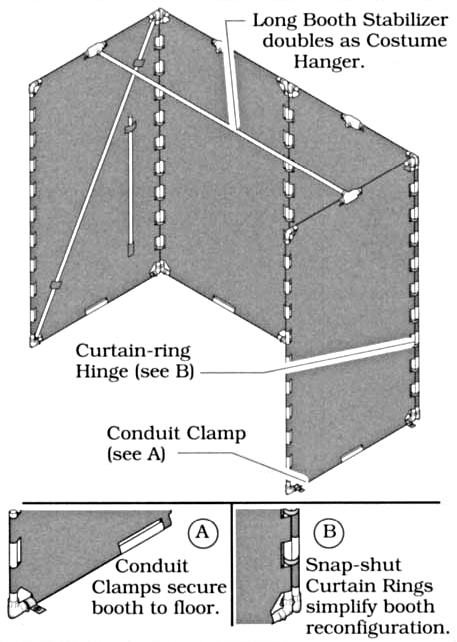Cheng Heng Lee |
Collapsible Change Booths |
Making provisions for quick changes is often among the last items on a TD’s to-do list. Having one or more of the easily stored, inexpensive quick change booths described here can help make the countdown to tech rehearsals less frantic. These booths are modeled after an equally useful item common to most shops — the welding screen.

FIGURE 1: PANEL CONSTRUCTION

FIGURE 2: A FINISHED FOUR-PANEL BOOTH
MATERIALS AND DIMENSIONS
The booth is made up of four identical panels hinged together. See Figure 1. Each panel consists of a 4′−0″ × 7′−0″ frame of ¾″ EMT conduit and a fabric cover. The tabbed pipe pocket sewn into the perimeter of the screen provides multiple opportunities for joining panels into booths like that shown in Figure 2. Velcro® straps and two sets of pockets sewn onto the fabric covers provide storage locations for two sizes of stabilizer/costume-hanger conduits. A list of the parts needed for a four-panel booth is laid out in Table 1. Table 2 presents a cut list of the framing members.
ASSEMBLY NOTES
Assembling the booth is very simple. Still, a few suggestions may be helpful. Before assembling the frames, paint all the pipes black and then wrap their ends with Teflon® tape. Painting the pipe will make the booth less visible. Keeping the joints loose allows for quick modification or reconfiguration of a setup and is particularly important at the tee in the top of each frame. After the individual frames are assembled and covered, they are hinged together with shower curtain rings or cable ties. The hinge joint doesn’t have to be particularly snug: the stabilizer/costume-hanger pipe makes up for the slop inherent in the hinge. Nevertheless, since an entire four panel booth weighs only a few pounds, securing it to the stage floor with conduit clamps or tying it off to walls or scenery backstage is recommended.
| 8 ea. | duvy panels with 2″ × 4″ tabbed pocket in each edge, 3′−1½″ × 6′−1½″ finished size |
| 1 ea. | 2″ × 4″ duvy pocket for short stabilizer |
| 12 ea. | ½″ conduit |
| 16 ea. | ½″ conduit |
| 4 ea. | ½″ conduit |
| 1 ea | roll of Teflon® tape |
| 27 ea. | shower curtain rings or cable ties |
| 3 ea. | 2″ × 4″ Velcro® hooks and loops |
TABLE 1: LIST OF BOOTH COMPONENTS
| 8 ea. | 6′−10½″ (uprights) |
| 4 ea. | 3′−10½″ (bottom member) |
| 8 ea. | 1′−10½″ (top member) |
| 1 ea. | 7′−10½″ (long stabilizer) |
| 1 ea. | 3′−10½″ (short stabilizer) |
TABLE 2: FRAME CUT LIST
VARIATIONS ON A FOUR-PANEL THEME
The modular structure of the frames allows for various configurations. Folding the frames into a 4′ × 4′ booth and using a short stabilizer between the top T-joints produces a compact, one-person dressing area. In this setup, you may want to turn one panel’s cover into a loosely hung tab curtain that can be quickly pushed aside.
CONCLUSION
Whether the reader chooses to build the panels exactly as described here or to modify the design to suit particular needs, the basic design of this booth has a few key advantages: it’s inexpensive; it’s easily built; it stores compactly; and, best of all, it can be set up for use in just a few minutes.
